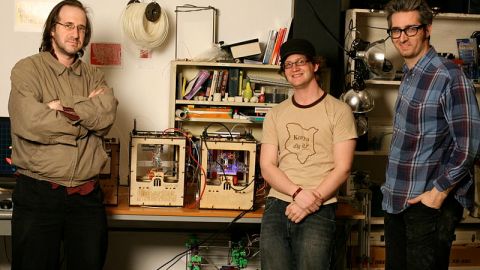Will the 3D Printing Revolution Produce the Next Apple?

Now that Apple appears to be losing its innovation mojo, it’s time to ask: Is there any company that can ever become the “next Apple”? In order to become the “next Apple,” the company would have to be the undisputed market leader in the technology sector with an unchallenged reputation for innovation, a rabid user base that looks forward to the launch of every new product with anticipation, and a rock star CEO along the lines of a Steve Jobs. There are some obvious suspects out there – Amazon, Google, Facebook or Twitter – but like Apple, these companies may have reached their pinnacle with the most recent Internet boom in Silicon Valley. In order to ever reach the massive stock market capitalization of Apple (on the magnitude of $400 billion to $500 billion), the “next Apple” will need to be driving a completely new trend within the tech world capable of radically changing consumer behaviors in ways we could never imagine.
That’s why the 3D printing revolution – commonly described as the “Next Industrial Revolution” – shows so much promise to produce the next Apple. Over the past twelve months, 3D printing has taken the technological world by storm as innovators figure out how to use the latest additive manufacturing technology to print out everything from small toys to large buildings. There’s now a real sense that 3D printing – once the exclusive preserve of die-hard tech enthusiasts and the DIY Maker crowd – is finally crossing over to the consumer mainstream. It’s now possible to pick up a desktop 3D printer for less than $1,000 – a psychologically important price level that starts to attract all the early innovators who splurged for the first iPhone and the first iPad.
Most encouragingly, the leading 3D printing companies are focused on enabling the creativity of the everyday person. As a result, some of the leading supporters of the 3D printing revolution are actually designers, architects and other creative professionals who are now able to create amazing, one-of-a-kind objects. These are exactly the same type of creative professionals who united behind Apple’s sleek design elements and the same type of consumer demographic that can lend an aura of “hipness” to 3D printing. And even if you don’t consider yourself a “creative professional,” there’s, umm, a creative and NSFW way to explore the 3D printing future.
For now, 3D printing darling MakerBot Industries has the greatest potential to become the next Apple. The company seems to have it all – a charismatic leader (Bre Pettis), a rabid fan community (Thingiverse), a huge support group within the Maker and DIY hobbyist movement and an amazing founder’s myth (a bunch of guys pooling their money together in a Brooklyn apartment they called the Bot Cave to build the first MakerBot 3D printer). It’s uncannily similar to watching Apple emerge from the Homebrew Computer Club movement more than 35 years ago. (I mean, just check out the accompanying photo – anybody it remind you of?) And, just like Apple, MakerBot’s 3D printers (like the latest MakerBot Replicator 2) command a premium pricing over those of their peers. While other 3D printer companies may sell their desktop 3D printers for less than $1,000, the MakerBot Replicator 2 has a price tag of $2199. Sounds just like Apple’s iPhone pricing strategy, which has accounted for the company’s prodigious margins over the past few years.
Is it overstating things to assume that the 3D printing revolution will ever produce the next Apple? Maybe. But consider that 3D printing is one of those exponential technologies that doubles in capabilities every few years. We started off printing tiny tchotchkes and toys, and may end up printing human organs. 3D printing, almost by its very definition, is the type of exponential technology described by Ray Kurzweil in his books about the Singularity. As a result, 3D printing is almost a lock to benefit from the Law of Accelerating Returns – within the next two decades, we may be able to 3D print just about anything – even a Stradivarius violin.
image: MakerBot Founders and Final Prototypes via Wikipedia





